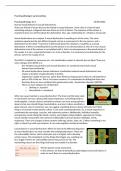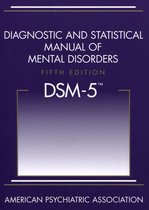Psychopathologie samenvatting
Psychopathology les 1 13/09/2023
Human sexual behavior & sexual dysfunctions.
There are all kind of issues that can be related to sexual behavior. In the clinic it’s hard to label
something and give a diagnosis because there are a lot of factors. The response of the partner is
essential in how you will feel about the dysfunction. Also, age, relationship etc. will play a strong role.
Sexual dysfunctions are complex. A sexual dysfunction is anything out of the norm. The same
symptom experienced by two different people can be an annoyance for the one person, and a
dysfunction for the other. If someone is distressed about the symptom, it qualifies as a sexual
dysfunction. If there is something there but the person is not stressed about it, then it is not a sexual
dysfunction (even if the partner is not satisfied with it, that is an incongruence in the sexual desire of
the couple, it is not a sexual dysfunction). So, to be a disorder, it is necessary to be disturbing for the
person, not for the couple per se.
The DSM-5 is helpful for insurances etc., the classification system is relevant but not ideal. There are
some changes from DSM4 to 5.
- (For females) sexual desire and arousal disorders are combined into female sexual
interest/arousal disorder.
- All sexual dysfunctions (except substance-/medication-induced sexual dysfunction) now
require a duration of approximately 6 months.
- Vaginismus (unable to have sex, pelvic floor flinches). Dyspareunia is that you will experience
pain in 50% of the sex. This is a lot more common. It is complicated to distinguish these two,
therefore they are now combined into genito-pelvic pain / penetration disorder (GPPPD).
- There are now subtypes for all disorders:
o Lifelong vs. acquired
o Generalized vs. situational
What can cause/maintain a sexual dysfunction? The brain and the body need
to synchronize to have a pleasurable sexual experience. Everything needs to
work together. Certain cultures and believe systems can have strong opinions
about certain sex related things (masturbation, anal sex). Culture sensitivity is
quite relevant, also in treatment, you can suggest something that you know will work, but if that
thing is not normal in that specific culture, it can work counterproductive. So, a sexual experience is
coordinated by neurologic, vascular, and endocrine systems. Additionally, individual sexuality
incorporates certain things like family, society, and religious things (beliefs, experiences). Finally,
sexual activity incorporates inter-personal relationships and each partner (attitudes, needs,
responses). There are changes in these systems (with age, phase, state, etc.). When something is not
right, or doesn’t go with your believes, it can cause negative emotional reactions.
Causal factors in sexual dysfunction. When we look at the different diagnoses
in sexual dysfunction, we must consider the predisposing factors. These are
the vulnerability factors, that is what puts you at a higher risk to develop
certain issues. The precipitants are the things that trigger you, anything can
be a trigger if there are vulnerability factors that put you at risk. The
maintaining factors are the things that keep you hooked in a disorder.
The bio-psycho-social assessment.
In this scheme, we look at biomedical, psychological and social factors in
order to see if there is a sexual dysfunction.
,Phases of sexual activity. There are many models in sexual human responding. The most famous one
is from Masters and Johnson, they proposed a four-stage “linear (successive)” model of human
sexual response. The four stages are: excitement, plateau, orgasm and resolution. However, there
are all kinds of things that can be different, such as the resolution time, or some people don’t have
orgasm, some people skip the excitement. This model is very linear and that is why not everybody
can recognize themselves in it because sexual response is not a linear & uniform process – thus, the
distinction between the phases might be artificial.
The sexual tipping point model. All the features can be put on the model and
then it depends on what outweighs the other and which way the thing will go
to. For example:
- Excitation: “I really want to have sex”
- Inhibition: “I gained weight, I don’t feel sexy”
This is a variable & dynamic process.
Specific sexual dysfunctions:
- Delayed Ejaculation (DE)
- Erectile Disorder (ED)
- Female Orgasmic Disorder
- Female Sexual Interest/Arousal Disorder
- Genito-Pelvic Pain/Penetration Disorders
- Male Hypoactive Sexual Desire Disorder (MHSDD)
- Premature (Early) Ejaculation
- Substance/medication-induced sexual dysfunction
- Other specified sexual dysfunction
- Unspecified sexual dysfunction
Substance/medication-induced sexual dysfunction.
This is the only sexual dysfunction that doesn’t have the 6 months criteria. This disorder must be
related to a substance that you were exposed to that has the potential to give sexual dysfunction as a
symptom.
Other specified sexual dysfunction.
If you have a patient with symptoms characteristic of a sexual dysfunction that cause clinically
significant distress but it doesn’t meet the full criteria for any of the disorders in the sexual
dysfunctions diagnostic class, then the other specified sexual dysfunction is used. The clinician has a
pretty good idea of what the symptoms come close with, but it doesn’t match all criteria.
Unspecified sexual dysfunction.
Clinician doesn’t have sufficient information to make a diagnosis. This category is used when the
clinician chooses not to specify the reason that the criteria are not met for a specific sexual
dysfunction, and includes presentations for which there is insufficient information to make a more
specific diagnosis.
Man’s sexual dysfunctions
Delayed ejaculation (DE)
This is characterized by a marked difficulty or inability to achieve desired ejaculation. This dysfunction
is more common in men over 50, this is because of their decline in testosterone. They need more
tactile penis stimulation. When people are aware of this, they find this comforting. Only 75% of men
report always ejaculating during sexual activity. There are many theories regarding the aetiology of
,DE but with little empirical data to support any particular theory. There are 3 common factors
associated with DE:
- Higher frequency of masturbation
- Idiosyncratic (particular) masturbatory style
- Disparity between the reality of sex with his partner compared to his preferred sexual
fantasy during masturbation. E.g., sometimes when masturbation is always without condom
and the sex with the partner is with condom, this might cause a problem. A suggestion here
could be to masturbate with a condom.
In the clinical setting:
- DE and ED can be hard to distinguish, DE is often mistakenly diagnosed as ED. Therefore, it is
very important that the assessment is correct.
- Focus on pleasure instead of function.
- Learn to focus attention on sexual stimuli.
- Cognitive restructuring.
- Suspend masturbatory activity temporarily.
- Use condoms during masturbation.
- Check relationship.
Erectile disorder (ED)
This is a failure to obtain or maintain an erection during partnered sexual activities.
- Marked decrease in erectile rigidity
- More common in men over 50
Most problems remit (disappear) without professional intervention. For the diagnosis, it needs to be
present for minimal 6 months. There are a lot of medicine that are well known to fix this. When we
look at the history, we see that there are various medications developed for this problem (such as
Viagra).
Cobra study the arteries in the penis are the smallest coronary arteries in the whole body. This is
interesting because there can be arteriosclerosis in coronary arteries, this happens in the smallest
arteries first, including in the penile arteries. In research they found that ED onset occurred before
CAD (coronary artery disease) in 71% with a mean time interval of 25 months.
Medication and relational drugs can have a negative impact on erectile function (e.g.
antihypertensives, antidepressants, recreational substances, etc.)
Assessment:
- Sexual development in childhood/adolescence - Depressive symptoms?
- Rule out PE (premature ejaculation) - Chronic/permanent?
- Hetero-bi-or homosexual orientation - Masturbatory experience?
- Partner/family/business/financial problems? - Partner/situation dependent?
- ED existing with masturbatory activities? - Mornings?
- General health conditions competing with sexual life?
There are questions you can ask to find out if the person is sufficiently aroused.
Male hypoactive sexual desire disorder (MHSDD)
The persistent deficient or absent sexual thoughts, fantasies, or desires. You don’t see this a lot in the
clinical setting because many men are often treated for different sexual diagnoses while they are
actually suffering from MHSDD. You also don’t see this very often because there is this expectation
that men can have sex at any time and therefore might feel shame. Sexual desire and sexual arousal
are overlapping constructs since both depend on the ability of an individual to process sexual
, information during sexual activity. When MHSDD is limited to a single partner, then it is not a sexual
dysfunction but a relationship problem. Having an erection and satisfaction are really different
things, having an erection says very little about the satisfaction a man is feeling. The prevalence of
MHSDD is greater in older men. Of all the men affected by the lack of desire for sex, about 65% of the
affected men are bothered by it. An explanation for this is that by the time that individuals reach
middle and old age, there is a natural decline in sexual desire, sexual capacity and the frequency of
sexual behavior.
Sufficient sexual stimulation is important for arousal to follow for women but also for men. Imagine
eating the same (your favourite) food every day, then it won’t remain your favourite food. Same
holds true for sex. You need novelty to prevent bedroom boredom. If we don’t include novelty in the
relationship, there will be habituation. Sexual feelings diminish during repeated erotic stimulation
and increase with the introduction of novel stimulation. This is important to remember in long term
relationships.
So, a side note on sexual pleasures in long term relationships:
- Sex plays a role in all phases of a relationship.
- Sexual desire is important to relationship satisfaction and stability low sexual desire
source of relational distress.
- Most prevalent complaint in long term relations is low sexual desire.
- Important to focus on the process, same as food, let’s look at sexual pleasure as flavour.
- But a decrease in sexual desire means a decrease in sexual frequency, this doesn’t
necessarily cause a decrease in relationship satisfaction.
Premature early ejaculation
Persistent or recurrent pattern of ejaculation during partnered sexual activity within 1 minute
following penetration or before individual wishes it. So, you come way before you want to. This can
be very painful for both persons in the relationship. The plateau phase is very short, and sometimes
not even existent. That is the issue, you need to work on the plateau phase, to increase it.
What if rapid ejaculation is natural? In animals, sexual intercourse is usually a brief episode. E.g., in
chimpanzees, the sequence of approach, penetration and ejaculation lasts just six seconds.
There are a lot of techniques to reduce the sexual stimulation:
- Squeeze and release.
- Change the thoughts away from the sexual arousal.
- Stop moving for a little bit of time to decrease the sexual arousal.
Women’s sexual dysfunctions
Female orgasmic disorder (FOD)
Delay, infrequency or absence of orgasm or reduced intensity of orgasm sensations. This is very
similar to men delayed ejaculation disorder. The orgasm doesn’t happen. There can be many reasons
why women can’t reach orgasms, including major medical causes. Risk factors for FOD are e.g.,
abuse, partner with PE or poor communication. The prevalence is difficult to determine.
Likelihood of NOT having orgasm problems related to:
- Manual genital caressing
- Self-use of vibrator
- Perception that sex is important
- Early age of first orgasm
- Cunnilingus
- Orgasm by penile motion





